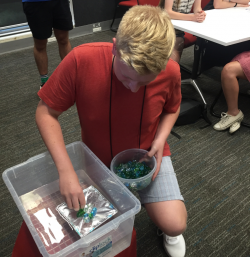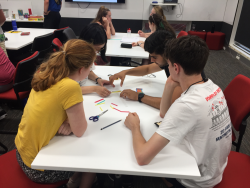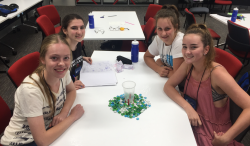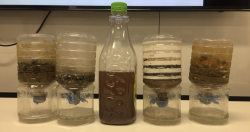“Can we just pour all of the marbles into our house?” NYSF 2018 Student, Tian, from Gladstone, QLD
Kicking off their NYSF 2018 STEM visits, students in the Newton Engineering interest group for Session A were treated to a workshop with the ACT student chapter of Engineers Without Borders (EWB). EWB Australia is a non-profit organisation that works within Australia and abroad to improve the quality of life of disadvantaged communities through education and the implementation of sustainable engineering projects.
Run by two ANU engineering students and executives of the Canberra student chapter, Sam Palmer and Sarah Callinan, the workshop aimed to clear up some of the misconception about engineering:
“Engineers respond to the needs of society by providing technological solutions to everyday problems in order to improve the quality of life,” said Sarah.
Students learned about the importance of considering appropriate technology in sustainable development. “Engineers must consider cost, physical environment, available materials and electricity, available labour force, and cultural considerations in order to design a solution that will actually work,” remarked Sam. Drawing upon their experiences on an EWB visit to Cambodia in 2017, Sam and Sarah presented the students with a real-life challenge:
The Tonlé Sap is a lake, located in central Cambodia. It expands its size in the wet season, meaning that residents need to adapt how they live in the changing environment. The NYSF students were set a challenge of how to build appropriate housing within this context, taking into consideration financial and material constraints. The task:
“Design a floating house to hold the most people. ”
Well... plastic straws, cups, sticky tape, string, foil/cling wrap, rubber bands, balloons and popsicle sticks, were available for use as building materials, and the people were marbles, but the students were keen to attack what was a challenging engineering problem all the same! To add an extra level of complexity and further demonstrate the concept of appropriate technology, students were given a tight budget and could only buy limited materials in which to make their house!
Working in groups, the designs were varied and colourful, some taking to raft, plate and bucket inspired houses.


Girl power ultimately dominated with the trio using a simple but effective design inspired by stilt houses! They smashed the other groups, pouring 114 marbles into their house, compared to the 34, three, and one marbles held by their competitors. Who says girls can’t do engineering?!

After a quick snack break, the students were presented with a second activity, aligned with the challenge of water filtration in developing countries. The challenge:
“Build a water filter to produce the cleanest water.”
Again, to demonstrate the concept of using appropriate technology, students were given a budget in which to buy charcoal, cheesecloth, cotton, gravel and sand to place in half a plastic water bottle. However, each group was given a different country and a different budget according to the average GDP of that country.

It didn’t look good for Cambodia, with a budget of only $20 compared to Australia’s $150, but they came through and won the challenge! It just goes to show that sometimes a lack of resources can inspire creative but effective designs.
The students had a great time in the workshop, particularly in bombarding Sam and Sarah with questions about their engineering studies!
“I’ve always wanted to travel, so being able to see that engineering can take you places was amazing,” Tian from Gladstone, QLD
For more information about the work of EWB, check out their website: https://www.ewb.org.au/
Brooke Krajancich, Communications Intern NYSF 2018 Session A and NYSF Alumna 2013.